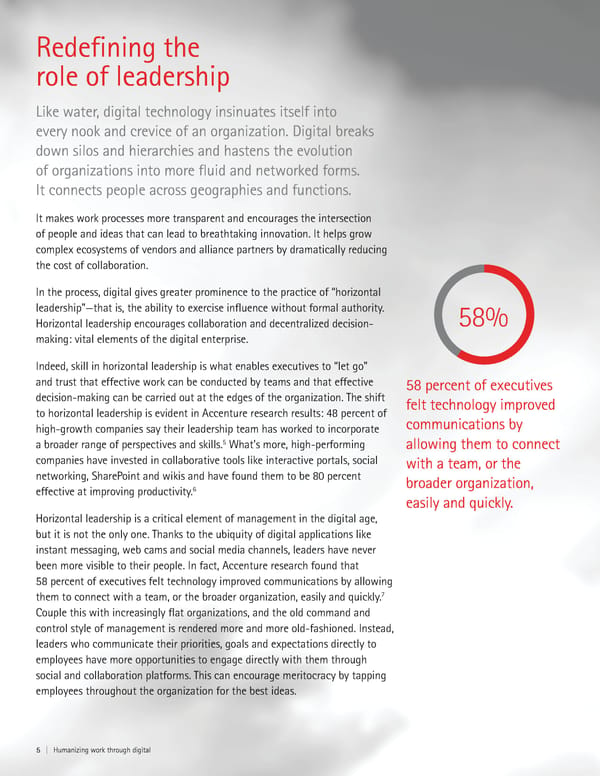Redefining the role of leadership Like water, digital technology insinuates itself into every nook and crevice of an organization. Digital breaks down silos and hierarchies and hastens the evolution of organizations into more fluid and networked forms. It connects people across geographies and functions. It makes work processes more transparent and encourages the intersection of people and ideas that can lead to breathtaking innovation. It helps grow complex ecosystems of vendors and alliance partners by dramatically reducing the cost of collaboration. In the process, digital gives greater prominence to the practice of “horizontal leadership”—that is, the ability to exercise influence without formal authority. 58% Horizontal leadership encourages collaboration and decentralized decision- making: vital elements of the digital enterprise. Indeed, skill in horizontal leadership is what enables executives to “let go” and trust that effective work can be conducted by teams and that effective 58 percent of executives decision-making can be carried out at the edges of the organization. The shift felt technology improved to horizontal leadership is evident in Accenture research results: 48 percent of communications by high-growth companies say their leadership team has worked to incorporate 5 a broader range of perspectives and skills. What’s more, high-performing allowing them to connect companies have invested in collaborative tools like interactive portals, social with a team, or the networking, SharePoint and wikis and have found them to be 80 percent broader organization, 6 effective at improving productivity. easily and quickly. Horizontal leadership is a critical element of management in the digital age, but it is not the only one. Thanks to the ubiquity of digital applications like instant messaging, web cams and social media channels, leaders have never been more visible to their people. In fact, Accenture research found that 58 percent of executives felt technology improved communications by allowing 7 them to connect with a team, or the broader organization, easily and quickly. Couple this with increasingly flat organizations, and the old command and control style of management is rendered more and more old-fashioned. Instead, leaders who communicate their priorities, goals and expectations directly to employees have more opportunities to engage directly with them through social and collaboration platforms. This can encourage meritocracy by tapping employees throughout the organization for the best ideas. 5 | Humanizing work through digital
 Humanizing Work Through Digital Page 4 Page 6
Humanizing Work Through Digital Page 4 Page 6